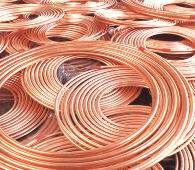 | « Back to article | Print this article |
 The flare up in the global non ferrous metal prices since June 2010 has benefited the players in general and the aluminium, lead and zinc producers in particular.
The flare up in the global non ferrous metal prices since June 2010 has benefited the players in general and the aluminium, lead and zinc producers in particular. The current fiscal witnessed buoyancy in the global and domestic non ferrous metal prices. LME aluminium prices flared up from US$ 1828.50 per tonne on 7th June 2010 to US$ 2539.50 on 7th February 2011.
Similarly, copper prices surged from US$ 6091 per tonne on 8th June 2010 to US$ 10148 per tonne on 14th February 2011. Zinc prices too sizzled from US$ 1595 per tonne on 7th June 2010 to US$2545.50 per tonne by 21st February 2011. Lead prices have also hardened from US$ 1558.50 per tonne on 7th June 2010 to US$ 2720 per tonne by 17th January 2011.
India is a primary producer of aluminium, zinc and lead from ore stage, but is a merchant producer of copper. It imports copper concentrates and smelts them into copper, thereby getting only treatment and refining charges for this conversion.
Only Hindustan Copper has captive mines with copper concentrates in India. So, on a relative basis, the integrated players producing aluminium, zinc, lead (Hindalco, Sterlite Industries (for aluminium), Hindustan Zinc, Hindustan Copper) etc have optimally benefited from the surge in the global and domestic prices thereof, than the copper smelters.
Duty Structure
|
Particulars |
Excise Duty |
Customs Duty |
|
Unwrought Aluminium |
10% |
5% |
|
Unwrought copper, copper anodes |
10% |
5% |
|
Unwrought Zinc |
10% |
5% |
|
Unwrought Lead |
10% |
5% |
|
Aluminium Waste & Scrap |
10% |
Nil |
|
Copper waste and scrap |
10% |
5% |
|
Zinc waste and scrap |
10% |
5% |
|
Lead waste and scrap |
10% |
5% |
|
Ores and Concentrate |
2% |
Broadly, there are two types of non ferrous metal producers primary and secondary. Primary producers produce metal from ores and concentrate, while secondary producers use scrap. The secondary producers have sought removal of customs duty on waste and scrap, emphasizing the need to encourage recycling of copper, zinc, lead etc. They are also seeking removal of special additional duty of 4% on import of copper, zinc and lead scrap.
The copper smelters seek removal of customs duty on ores and concentrate, which at present attract 2% customs duty. As Hindalco and Sterlite Industries import their entire copper concentrate requirement, and as Hindustan Copper utilizes its copper concentrate production for captive conversion into copper, there will not be any damage to the Indian copper concentrate sector, if the customs duty on copper concentrate is removed.
On the other hand, despite spike in the global copper prices, the treatment and refining charges (Tc/Rc margins) are relatively subdued due to sluggish production in copper concentrate. In this background, the copper smelters seek removal of customs duty on copper concentrate.
Scrips to Watch
Hindalco, Sterlite Industries, Hindustan Zinc, Hindustan Copper
Outlook
The buoyancy in the global non ferrous metal prices have meant surge in profits of the integrated aluminium, zinc and lead producers. However, the upside was relatively limited for the copper smelters, as the Tc/Rc margins were relatively subdued, and they seek removal of customs duty on copper concentrate imports.
The secondary producers seek removal of customs duty on non ferrous metal waste and scrap.
Even if this is conceded, it is unlikely to affect the domestic non ferrous metal prices, which are linked to landed cost of imports.
If the government reduces the customs duty on primary aluminium, copper, zinc and lead, then the domestic prices will ease, and if they are hiked, it will add to pricing power and profitability of the domestic producers.
On the other hand, if the excise duties are hiked, the impact will largely be limited, considering that non ferrous metals are intermediate products and the CENVAT is a pass through item on value addition.